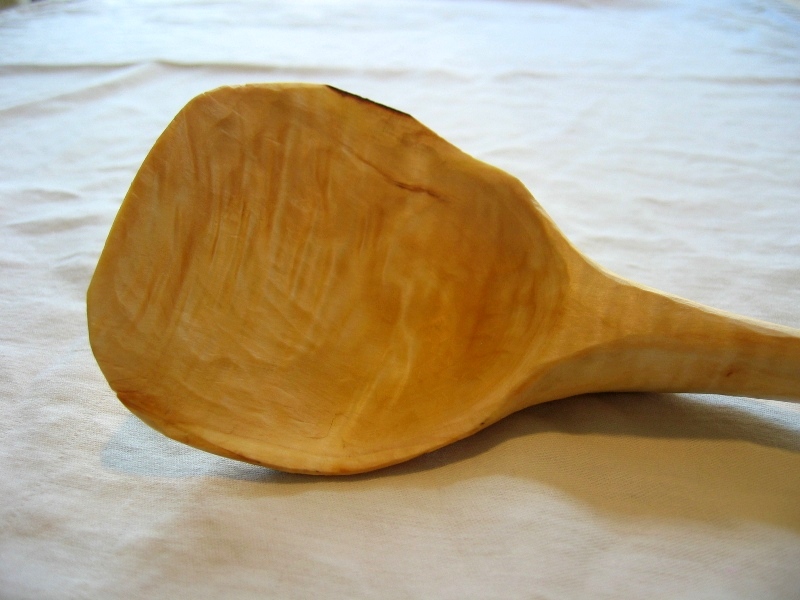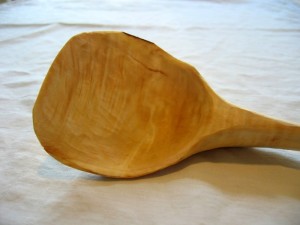
A spoon with history
I used to, but no longer, live next to the oldest tree in Groningen. I say used to, not because I moved, but because the tree, a horse chestnut, no longer stands here. It had been getting weaker and, either for safety reasons, or because it was terminal, the city decided to have it removed and replaced by a copper beech.
 I loved that tree; our deck stood right under its canopy and, in the summer it provided shade, in the winter some cover from the rain. It had great presence and I somehow felt rooted, living next to it. More so than the 13th-century church that stands 40 or so metres north of here, the tree was a strong connection with the past of my newly-adopted home. So I was sad when we received a letter from the city explaining how, when, and why they would be removing it.
I loved that tree; our deck stood right under its canopy and, in the summer it provided shade, in the winter some cover from the rain. It had great presence and I somehow felt rooted, living next to it. More so than the 13th-century church that stands 40 or so metres north of here, the tree was a strong connection with the past of my newly-adopted home. So I was sad when we received a letter from the city explaining how, when, and why they would be removing it.
As with all good funerals, the mood on the day was festive. It was a grand event, sad as it was. The street was blocked off, a crazy-large crane was driven in, and the half-dozen or so arborists and workers posed for their shot at the base of the tree. Since our building stands between the road and the garden, every piece that was moved to and from the garden flew above our heads. It felt a bit uneasy, but how often do you get the chance to have a 5m tree trunk segment hovering above?
Bit by bit, the arborists made short work of the tree and a few hours later, all that remained was the stump and dozens of removed branches, some as wide as half a meter. When the workers left for the night, I knew I wanted to keep a piece of that tree. I wanted those roots to stay with me for a while longer. So I hauled up to our apartment two logs that were each approximately 40x60cm.
Now, green woodworking is not what I am accustomed to. To be clear, green lumber is freshly cut wood, with a very high moisture content. As time passes, the wood loses most of this moisture, in an effort to reach an equilibrium with the humidity levels in the atmosphere. Because wood shrinks as it loses moisture, furniture is (or should be) made from wood that has already dried (seasoned) to as close to the equilibrium as possible. Even then, however, because atmospheric humidity levels change with the seasons, good furniture is built with consideration for the way the wood will continue to move through the seasons and through the years. The two materials, green and seasoned wood,have different properties, are worked with different tools and techniques, and their products have different qualities.
As I mentioned, I am new to this type of woodworking. All the work I have done so far has been with dry, seasoned wood: furniture, boxes, that sort of thing. I have, however, been curious about working with green wood for years now, more so since visiting the sites of Robin Wood (really, what a great name!) and Peter Follansbee. They both do incredible work.
The months that followed, were not conducive to doing much with my stashed logs. The winter was long and dark; work was very busy; we had a new addition to the family… Fast forward to a couple of weeks ago when it no longer was dark and cold, work had slowly become a bit quieter, and we had become used to being 5 instead of 4, and I looked at those logs with renewed interest. With a small Japanese hatchet that I have, I decided to rive a few slices and make a spoon, similar in process (and, I hoped, in elegance) to the ones that Robin Wood makes.
 One of the logs used to have a branch coming out of it, so I decided to try to use the natural bend in the wood fibres as the two limbs meet, to form the handle and bowl of my spoon. Peter Follansbee shows something similar (and much more successful) here. As it turns out, the way the two limbs met, made the wood fibres curl and splitting the wood along those fibres was difficult, as was the carving of the spoon bowl, but I am jumping ahead here. After separating a slice of wood that had roughly the right shape, I used the hatchet to hew it to the shape of a spoon. That was by far the most interesting part of the process (shown very nicely in the video linked to in the previous paragraph). The hatchet was beautifully sharp and short, fast movements proved to be surprisingly accurate. So much so, that 90% of the shaping was done with the hatchet. It chopped, it sliced, it shaved, it did it all! It’s so much fun working with good quality tools. Seeing as I have no tools designed for this sort of work (though I did just order some for the future), the final stages of the carving, smoothing the handle and carving out the bowl, were done with a couple of chisels and gouges and a small handplane I made last year. In the end, I can say that I really enjoyed this process and hope to repeat it in the near future. The finished spoon (in the picture on the right) will be one of the reincarnations of this beautiful tree that stood here since the 19th century. I hope I have done it justice. For more photos, click here.
One of the logs used to have a branch coming out of it, so I decided to try to use the natural bend in the wood fibres as the two limbs meet, to form the handle and bowl of my spoon. Peter Follansbee shows something similar (and much more successful) here. As it turns out, the way the two limbs met, made the wood fibres curl and splitting the wood along those fibres was difficult, as was the carving of the spoon bowl, but I am jumping ahead here. After separating a slice of wood that had roughly the right shape, I used the hatchet to hew it to the shape of a spoon. That was by far the most interesting part of the process (shown very nicely in the video linked to in the previous paragraph). The hatchet was beautifully sharp and short, fast movements proved to be surprisingly accurate. So much so, that 90% of the shaping was done with the hatchet. It chopped, it sliced, it shaved, it did it all! It’s so much fun working with good quality tools. Seeing as I have no tools designed for this sort of work (though I did just order some for the future), the final stages of the carving, smoothing the handle and carving out the bowl, were done with a couple of chisels and gouges and a small handplane I made last year. In the end, I can say that I really enjoyed this process and hope to repeat it in the near future. The finished spoon (in the picture on the right) will be one of the reincarnations of this beautiful tree that stood here since the 19th century. I hope I have done it justice. For more photos, click here.
Thank you for your visit here today; share your thoughts in the comment box below.
-Tassos

“hew” is my favorite word of the day